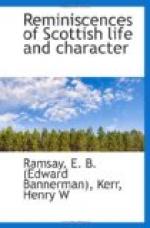I would introduce here a specimen of the precise sort of changes to which I would refer, as an example of the reminiscences intended to be introduced into these pages. We have in earlier editions given an account of the pains taken by Lord Gardenstone to extend and improve his rising village of Laurencekirk; amongst other devices he had brought down, as settlers, a variety of artificers and workmen from England. With these he had introduced a hatter from Newcastle; but on taking him to church next day after his arrival, the poor man saw that he might decamp without loss of time, as he could not expect much success in his calling at Laurencekirk; in fact, he found Lord Gardenstone’s and his own the only hats in the kirk—the men all wore then the flat Lowland bonnet. But how quickly times change! My excellent friend, Mr. Gibbon of Johnstone, Lord Gardenstone’s own place, which is near Laurencekirk, tells me that at the present time one solitary Lowland bonnet lingers in the parish.
Hats are said to have been first brought into Inverness by Duncan Forbes of Culloden, the Lord President, who died in 1747. Forbes is reported to have presented the provost and bailies with cocked hats, which they wore only on Sundays and council days. About 1760 a certain Deacon Young began daily to wear a hat, and the country people crowding round him, the Deacon used humorously to say, “What do you see about me, sirs? am I not a mortal man like yourselves?” The broad blue bonnets I speak of long continued to be worn in the Highland capital, and are still occasionally to be seen there, though generally superseded by the Glengarry bonnet and ordinary hat. It is a minor change, but a very decided one.
The changes which have taken place, and which give rise to such “Reminiscences,” are very numerous, and meet us at every turn in society. Take, for example, the case of our Highland chieftains. We may still retain the appellation, and talk of the chiefs of Clanranald, of Glengarry, etc. But how different is a chieftain of the present day, even from some of those of whom Sir Walter Scott wrote




